
Fulgurites are unusual tubes that form when lightning strikes sandy areas. These formations get their name from fulgur, Latin for lightning, and are also called ‘fossilised lightning’. Fulgurites resemble roots with a rough surface. However, the inner surface is smooth and glassy, because of the fact that the sand cools rapidly and solidifies. Fulgurites are rare; while lightning strikes the Earth’s surface at least a million times each day, these bolts have to be low and powerful enough to melt sand or soil into these shapes. Fulgurites are very fragile as they are hollow. Since they trap air bubbles, old fulgurites are used to study the composition of air in ancient times. A 250-million-year-old fulgurite found in the Sahara desert, for instance, suggests this area of the world was once a fertile area with frequent storms.
Fulgurites are very fragile, as they are hollow and have lots of air spaces. They can get longer than 10 feet, although most are a few inches. Since they trap air bubbles, old fulgurites can be used to study the composition of air in ancient times. Additionally, the number of fulgurites found along with the date formed can provide information on the frequency of lightning.
The Libyan Desert is pure white sand composed of quartz. Fulgurites have been found in that desert. Also discovered were pieces of fused quartz with the clarity of clear glass. Such a piece adorns the mummified body of Tutankhamen. The piece is estimated to have formed 26 million years ago. To form such a piece of glass requires very hot temperatures, hotter than lightning. The most reasonable theory is that this was formed by a high-energy impact of a meteor.
Picture Credit : Google



